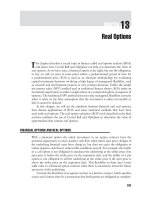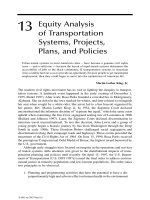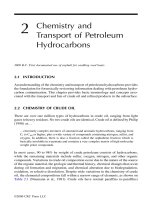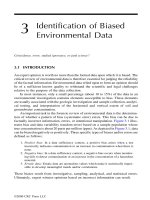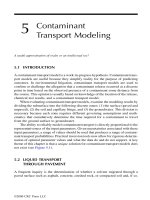Digital Terrain Modeling: Principles and Methodology - Chapter 13 ppt
Bạn đang xem bản rút gọn của tài liệu. Xem và tải ngay bản đầy đủ của tài liệu tại đây (2.69 MB, 18 trang )
DITM: “tf1732_c013” — 2004/10/22 — 16:37 — page 267 — #1
CHAPTER 13
Interpretation of Digital Terrain Models
In Chapter 12, the visualization of DTM was discussed. Visualization can on the
one hand be regarded as a representation and on the other hand compared to visual
analysis. This chapter will cover DTM-based terrain analysis, or DTM interpretation.
13.1 DTM INTERPRETATION: AN OVERVIEW
To interpret a DTM means “to understand the terrain characteristics through
the extraction/computation of the parameters.” DTM interpretation is also called
DTM-based terrain analysis.
The term digital terrain analysis means different things to people with different
backgrounds because they emphasize different aspects. In some literature, a large part
of digital terrain analysis is on interpolation methods for terrain surface modeling,
which was discussed in Chapter 6; in some other literature a large part is on visual-
ization of DTMs, which was the topic of Chapter 12; and for a third group, it means
the derivation of attributes from terrain surfaces, which is the main content of this
chapter.
It isunderstandablethatpeople fromdifferentdisciplinesare interested indifferent
sets of attributes of the terrain surface. A detailed discussion on all the possible attrib-
utes can be foundinother literature (e.g., Moore et al. 1994; Wilson and Gallant2000).
This chapter considers the computation of commonly used attributes, such as slope
and aspect, area and volume, roughness parameters, and hydrological parameters.
In addition, the derivation of viewsheds and the analysis of inter-visibility between
points on terrain surfaces are also presented.
13.2 GEOMETRIC TERRAIN PARAMETERS
This section discusses the computational models for geometric parameters, including
surface area, projection area, and volume.
267
© 2005 by CRC Press
DITM: “tf1732_c013” — 2004/10/22 — 16:37 — page 268 — #2
268 DIGITAL TERRAIN MODELING: PRINCIPLES AND METHODOLOGY
13.2.1 Surface and Projection Areas
The formula for the computation of the surface area of a triangle, S
, is as follows:
S
=
P(P −D
1
)(P − D
2
)(P − D
3
) (13.1)
where D
i
represents the length of the edge opposite the vertex I and is computed
from Equation (13.2).
P =
1
2
(D
1
+D
2
+D
3
)
D
1
=
(x
3
−x
2
)
2
+(y
3
−y
2
)
2
+(z
3
−z
2
)
2
D
2
=
(x
3
−x
1
)
2
+(y
3
−y
1
)
2
+(z
3
−z
1
)
2
D
3
=
(x
1
−x
2
)
2
+(y
1
−y
2
)
2
+(z
1
−z
2
)
2
(13.2)
The surface area of the whole DTM, S, is the sum of the surface areas of all triangles.
S =
N
i=1
S
,i
(13.3)
where N is the total number of triangles in the area. If the DTM is in a grid form,
then each grid cell can be split into two triangles.
The area of the surface projected on the horizontal plane can also be computed
from Equation (13.1). In this case, the heights for the three vertices of a triangle are
set to 0. On the other hand, a more convenient method can be used for the computation
of a horizontal area. Figure 13.1 shows the principle. In this figure, the three vertices
are points 1, 2, and 3. If these three points are projected to the x-axis, then points 1
,2
,
and 3
are obtained. Points 1 and 2, together with 1
and 2
, form a trapezoid 1, 2, 3.
1
2
3
1′ 2′ 3′
y
x
Figure 13.1 The area of 1, 2,3 to be computed from three trapeziods.
© 2005 by CRC Press
DITM: “tf1732_c013” — 2004/10/22 — 16:37 — page 269 — #3
INTERPRETATION OF DIGITAL TERRAIN MODELS 269
Similarly, points 2 and 3, together with 2
and 3
, form another trapezoid; and points
3 and 1, together with 3
and 1
, form the third trapezoid. By adding the areas of the
first two trapezoids together and subtracting the area of the third trapezoid, the area
of the triangle 1, 2, 3 is obtained, that is,
A
123
=|A
122
1
|+|A
233
2
|−|A
311
3
| (13.4)
However, if the vertices are arranged clockwise and the areas are computed
according to Equation (13.5), then the value of A
311
3
will be negative and then
Equation (13.4) could be written as Equation (13.6):
A
122
1
=
y
1
+y
2
2
×(x
2
−x
1
)
A
233
2
=
y
2
+y
3
2
×(x
3
−x
2
)
A
311
3
=
y
3
+y
1
2
×(x
1
−x
3
)
(13.5)
A
123
= A
122
1
+A
233
2
+A
311
3
=
1
2
[(y
1
+y
2
)(x
2
−x
1
) +(y
2
+y
3
)(x
3
−x
2
) +(y
3
+y
1
)(x
1
−x
3
)]
=
1
2
(y
1
x
2
+y
2
x
3
+y
3
x
1
−x
1
y
2
−x
2
y
3
−x
3
y
1
)
=
1
2
x
1
y
1
1
x
2
y
2
1
x
3
y
3
1
(13.6)
In fact, Equation (13.6) can be extended to compute the area of any polygon with
N points:
A =
1
2
N
i=1
(y
i
×x
i+1
−x
i
×y
i+1
) (13.7)
This formula requires the (N + 1)th point. However, it does not exist in the point
list of the polygon. As a result, the first point is used as the (N +1)th point so as to
make this polygon closed.
Similarly, as shown in Figure 13.2, the area covered by a profile (or a section)
consisting of N points can be computed as follows:
A
profile
=
n−1
i=1
z
i
+z
i+1
2
×D
i,i+1
(13.8)
where D
i,i+1
is the horizontal distance between the ith and (i +1)th points.
© 2005 by CRC Press
DITM: “tf1732_c013” — 2004/10/22 — 16:37 — page 270 — #4
270 DIGITAL TERRAIN MODELING: PRINCIPLES AND METHODOLOGY
1
2
3
4
N
D
2,3
D
1,2
Reference
z
D
Figure 13.2 Area covered by a profile.
(a) (b)
A
∆
z
1
z
2
z
3
A
Cell
z
1
z
2
z
3
z
4
Figure 13.3 Volume calculation-based TIN and grid DTM.
13.2.2 Volume
After the horizontal area A
covered by a triangular facet is computed, the volume
of the triangular prism covered by this triangular facet (see Figure 13.3a) can be
computed as follows:
V
3
=
z
1
+z
2
+z
3
3
×A
(13.9)
If the DTM is in a grid form, the volume covered by a cell (Figure 13.3b) can be
computed as follows:
V
4
=
z
1
+z
2
+z
3
+z
4
4
×A
Cell
(13.10)
where A
Cell
is the horizontal area covered by the cell.
By using either of these two formulae, the volume required for cutoff or fill-up
for an engineering design on the DTM can then be computed as follows:
V
=
V
originalDEM
−V
newDEM
(13.11)
The result of V can be interpreted as follows:
1. V>0, cutting off
2. V>0, filling up
3. V = 0, no need to do either.
© 2005 by CRC Press
DITM: “tf1732_c013” — 2004/10/22 — 16:37 — page 271 — #5
INTERPRETATION OF DIGITAL TERRAIN MODELS 271
13.3 MORPHOLOGICAL TERRAIN PARAMETERS
Morphometric terrain parameters are those that can be derived directly from the DTM
using some local operations, such as slope and aspect, complexity index, and so on.
13.3.1 Slope and Aspect
Although slope was discussed in Chapter 2 and the use of slope information presen-
ted in Chapters 4 and 7, yet no rigorous definition has been given so far. Slope is
the first derivative of a surface and has both magnitude and direction (i.e., aspect).
That is, slope is a vector consisting of gradient and aspect. The term slope used in the
previous chapters is called gradient in geomorphological literature. The term aspect
is defined as the direction of the biggest slope vector on the tangent plane projected
onto the horizontal plane. Aspect is the bearing (or azimuth) of the slope direction
(Figure 13.4), and its angle ranges from 0 to 360
◦
. (Note that in some literature, east
is used as the reference direction for aspect instead of north.) In this context, the term
slope is still used to refer to the gradient.
Suppose the surface function is
z = f(x, y) (13.12)
Then, the slope is defined as
Slope
x
=
df
dx
= f
x
Slope
y
=
df
dy
= f
y
(13.13)
Slope can be derived from the TIN or grid DTM using simple local operations.
Suppose the three vertices of a 3-D triangular facet are points 1, 2, and 3. The normal
3
1
3
2
Slope
Slope
N
N
P
P
Figure 13.4 Definitions of slope and aspect.
© 2005 by CRC Press
DITM: “tf1732_c013” — 2004/10/22 — 16:37 — page 272 — #6
272 DIGITAL TERRAIN MODELING: PRINCIPLES AND METHODOLOGY
(i.e., a vector) of this triangular facet at point 3 can be computed as follows:
N =
ijk
x
1
y
1
z
1
x
2
y
2
z
2
= i(y
1
z
2
−y
2
z
1
) −j(x
1
z
2
−x
2
z
1
) +k(x
1
y
2
−x
2
y
1
)
(13.14)
where i, j , and k are the unit vectors in the x, y, and z directions.
The projection of the
N onto the horizontal plane
P is computed as follows:
P = i(y
1
z
2
−y
2
z
1
) −j(x
1
z
2
−x
2
z
1
) (13.15)
The slope angle of the triangle, α, is then computed as follows:
sin α =
|P |
|N|
(13.16)
The aspect of this slope direction, β, is computed as follows:
tan β =
−
x
1
z
2
−x
2
z
1
y
1
z
2
−y
2
z
1
(13.17)
Many approaches are available to compute slope and aspect from a grid DTM.
However, no attempt is made to introduce all of them. Instead, only some simple
methods are presented. Figure 13.5 is a window with nine cells from a grid DTM.
From this window, the slope and aspect values of the central cell, that is, with
height z
0
, can be estimated as follows:
Slope = tan α =
Slope
2
Row
+Slope
2
Col
(13.18)
Aspect = tan β =
Slope
Col
Slope
Row
(13.19)
In these formulae, Slope
Row
and Slope
Col
are the slopes in the row and column
directions, respectively. If the row is west to east, then Slope
we
is normally used to
denote Slope
Row
, and likewise Slope
sn
to denote Slope
Col
.
z
5
z
2
z
6
z
1
z
0
z
3
z
8
z
4
z
7
Figure 13.5 A window for the computation of slope and aspect value.
© 2005 by CRC Press
DITM: “tf1732_c013” — 2004/10/22 — 16:37 — page 273 — #7
INTERPRETATION OF DIGITAL TERRAIN MODELS 273
Methods for the computation of the slopes in these two directions are listed in
Table 13.1. In this table, the variable d is as usual the grid interval. Figure 13.6 shows
an example of slope and aspect maps of an area: the contours and gray image are
shown in Figure 12.9. Comparative analysis has also been made by Skidmore (1989)
and Liu (2002). It has been revealed (Liu 2002) that method 1 has the highest accuracy
and computational efficiency, and method 2 comes second. However, method 1 has
not yet been implemented in popular commercial GIS software.
Table 13.1 Methods for the Computation of Slopes in Row and Column Directions
Equations for Slope in Row Equation
No. References and Column Directions No.
1 Ritter 1987; Slope
we
=
z
3
−z
1
2 × d
, Slope
sn
=
z
2
−z
4
2 × d
(13.20)
Zevenbergen and
Thorne 1987
Slope
we
=
(z
7
+2z
3
+z
6
) − (z
8
+2z
1
+e
5
)
8 × d
2 Horn 1981 (13.21)
Slope
sn
=
(z
6
+2z
2
+z
5
) − (z
7
+2z
4
+z
8
)
8 × d
Slope
we
=
(z
7
+
√
2z
3
+z
6
) − (z
8
+
√
2z
1
+z
5
)
(4 + 2
√
2)d
3 Unwin 1981 (13.22)
Slope
sn
=
(z
6
+
√
2z
2
+z
5
) − (z
7
+
√
2z
4
+z
8
)
(4 + 2
√
2)d
4 Sharpnack and G = Slope
we
=
(z
7
+z
3
+z
6
) − (z
8
+z
1
+z
5
)
6 × d
Akin 1969; (13.23)
Hengl et al. 2003 H = Slope
sn
=
(z
6
+z
2
+z
5
) − (z
7
+z
4
+z
8
)
6 × d
(a) (b)
0–5
5–10
10–20
20–30
30–40
40–58
1 0 1 Kilometers 1 0 1 Kilometers
Slope
(degrees)
Flat
N
NE
E
SE
S
SW
W
NW
Aspect
Figure 13.6 An example of slope and aspect maps of an area (as shown in Figure 12.9):
(a) slope map and (b) aspect map.
© 2005 by CRC Press
DITM: “tf1732_c013” — 2004/10/22 — 16:37 — page 274 — #8
274 DIGITAL TERRAIN MODELING: PRINCIPLES AND METHODOLOGY
13.3.2 Plan and Profile Curvatures
Hengl et al. (2003) regarded Equation (13.23) as the Evens–Young method. By
this method, the three second derivatives of the terrain surface can also be derived
as follows:
D =
d
2
f
dx
2
=
(z
1
+z
3
+z
5
+z
6
+z
7
+z
8
) −2(z
0
+z
2
+z
4
)
3 ×d
2
E =
d
2
f
dy
2
=
(z
2
+z
4
+z
5
+z
6
+z
7
+z
8
) −2(z
0
+z
1
+z
3
)
3 ×d
2
F =
d
2
f
dx dy
=
z
6
+z
8
−(z
5
+z
7
)
4 ×d
2
(13.24)
Using Equations (13.23) and (13.24), the curvature can then be computed as shown in
Table 13.2 (extracted from Hengl et al. 2003). The signs of the curvatures are defined
in Figure 13.7. It can be seen that for plan curvature, a positive value indicates
the divergence of the flow and a negative value the concentration of the flow and for
profile curvature, a positive value indicates the convex profile and a negative value the
concave profile. The mean curvature is the average of the plan curvature. Figure 13.8
shows an example of curvature maps of the area whose slope and aspect maps are
shown in Figure 13.6.
Table 13.2 Methods for the Computation of Curvatures
Equation
Name Equations No.
Plan curvature PlanC =−
H
2
×D −2 ×G ×H ×F +G
2
×E
(G
2
+H
2
)
1.5
(13.25)
Profile curvature ProfC =−
G
2
×D +2 ×G ×H ×F +H
2
×E
(G
2
+H
2
) × (1 +G
2
+H
2
)
1.5
(13.26)
Mean curvature MeanC =−
(1 + H
2
) × D −2 ×G ×H ×F + (1 +G)
2
×E
(G
2
+H
2
) × (1 +G
2
+H
2
)
1.5
(13.27)
(a) (b) (c) (d)
z
z
y
x
x
y
Figure 13.7 The sign of plan curvature (PlanC) and profile curvature (ProfC): (a) positive PlanC;
(b) negative PlanC; (c) positive ProfC; and (d) negative ProfC.
© 2005 by CRC Press
DITM: “tf1732_c013” — 2004/10/22 — 16:37 — page 275 — #9
INTERPRETATION OF DIGITAL TERRAIN MODELS 275
(a)
(b)
Plan curvature
(radians/100 m)
–55– –50
–50– –40
–40– –30
–30– –20
–20– –10
–10–0
0–10
10–20
10–25
1 0 1 Kilometers 1 0 1 Kilometers
Profile curvature
(radians/100 m)
–20– –15
–15– –10
–10– –5
–5–0
0–5
5–10
10–15
15–20
20–25
25–30
Figure 13.8 Maps of plan curvature and profile of the area as shown in Figure 12.9: (a) plan
curvature map and (b) profile curvature map.
13.3.3 Rate of Change in Slope and Aspect
In Figure 13.5, suppose the slope of grid point 0 is Slope
0
, and the slope of grid
point j is Slope
j
, j = 1,2, , 7, 8, then the rates of change in slope in grid cell 0
are as follows:
SR
0,j
=
Slope
j
−Slope
0
d
, for j = 1, 2, 3, 4
Slope
j
−Slope
0
√
2d
, for j = 5, 6, 7, 8
(13.28)
where d is the grid interval. There are eight values for the rate of slope change. The one
with the maximum magnitude is taken as the rate of slope change, that is,
SR
0
= SGN
S
max
|SR
max
| (13.29)
where |S
max
|=MAX(|SR
0,1
|, |SR
0,2
|, |SR
0,3
|, |SR
0,4
|, |SR
0,5
|, |SR
0,6
|, |SR
0,7
|,
|SR
0,8
|) and SGN
S
max
represents the sign of S
max
. For example, if SR
0,4
has the
largest absolute value, then SR
0
= SR
0,4
. The computation of the rate of aspect
change is done exactly the same way.
13.3.4 Roughness Parameters
The roughness of a DTM surface is defined as the ratio of the surface area S and its
projection onto the horizontal plane (i.e., the horizontal area A):
Roughness
A
=
S
A
(13.30)
When Roughness
A
= 1, which is the smallest possible value, it means that the DTM
surface is a horizontal surface.
It can be noted that the roughness values of two inclined planes will be different if
the angles are different, although both are planes. This is a serious deficiency. Another
© 2005 by CRC Press
DITM: “tf1732_c013” — 2004/10/22 — 16:37 — page 276 — #10
276 DIGITAL TERRAIN MODELING: PRINCIPLES AND METHODOLOGY
commonly used method is to make use of the two average heights along the diagonal
(see Figure 13.5):
Roughness
z
=
z
5
+z
7
2
−
z
6
+z
8
2
(13.31)
Another interesting parameter is the convexo-concave coefficient. It is defined as
CC =
(z
max
+z
o
max
)/2
z
mean
(13.32)
where z
max
is the height point of the four nodes of a grid cell; z
o
max
is the height of
the node opposite the highest node along the diagonal; and z
mean
is the mean value
of the four heights. The result of CC can be interpreted as follows:
1. CC > 0: convex shape
2. CC < 0: concave shape
3. CC = 0: level.
13.4 HYDROLOGICAL TERRAIN PARAMETERS
One of the major tasks in digital terrain analysis is the computation of hydrological
parameters, which are used to model the mass (e.g., water, sediments, and nutrient)
transportation and flow between land units. A number of important parameters
have been proposed, for example, total contributing area, specific catchment area,
compound topographic index, and stream power index. The results from the mod-
els form important input to, for example, the development of soil erosion models,
land use and land evaluation, landslide prediction, and catchment and drainage net-
work analysis (Zhou and Liu 2002). However, all these are the secondary terrain
parameters and they are commonly derived from a more fundamental element —
the flow model. A detailed discussion of these secondary parameters can be found
elsewhere (e.g., Wilson and Gallant 2000; Hengl et al. 2003). In this section, only
flow models are discussed, including flow direction, flow accumulation and lines,
as well as catchments and drainage networks.
13.4.1 Flow Direction
The fundamental principle behind the determination of flow direction is that water
will flow downhill (from a higher place to a lower place). On a terrain surface,
peaks are the maxima and pits are the minima. Ridge lines connect local maxima
and valleys (or ravines) lines connect local minima. Therefore, water will flow from
peaks and ridge lines to valleys and pits. The direction of flow can also be determined
using a DTM.
There are two general approaches:
1. Single-flow direction (SFD): The totalamount of flow shouldbe received bya single
neighboring cell that has the maximum downhill slope to the current cell, as shown
© 2005 by CRC Press
DITM: “tf1732_c013” — 2004/10/22 — 16:37 — page 277 — #11
INTERPRETATION OF DIGITAL TERRAIN MODELS 277
78 72 69
74 67 56
69 53 44
78 72 69
74 67 56
69 53 44
78 72 69
74 67 56
69 53 44
(a) (b) (c)
Figure 13.9 Approaches for the determination of flow direction: (a) SFD, D4; (b) SFD, D8;
and (c) MFD.
in Figure 13.9(a) (only four possible directions) and Figure 13.9(b) (all eight
possible directions).
2. Multiple-flow direction (MFD): The flow from the current cell is distributed to
all lower neighboring cells according to some criteria, slope and flow width
(i.e., contour length), as shown in Figure 13.9(c) and expressed by Equation (13.33)
(Quinn et al. 1991).
F
i
=
L
i
×tan α
i
n
i=1
L
i
×tan α
(13.33)
where F
i
is the proportional flow to the ith neighboring cell; L
i
is the flow width,
which is equal to (
√
2/4)d for the direction along the diagonal and (1/2)d for four
side neighbors (where d is the grid interval); and α
i
is the slope angle of the ith
neighboring cell.
A systematic classification of algorithms for the determination of flow direction
based on these two approaches has been given by Zhou and Liu (2002). In this section,
only the basic principles are introduced through simple algorithms. More precisely,
only the deterministic eight-node (D8) is introduced because of its simplicity and
wide implementation in GIS. However, it has been found from experimental testing
results that D8 may produce unacceptable errors and the warning is that “care must
be taken if they are used in real-world applications where accuracy is of concern”
(Zhou and Liu 2002).
The principles of D8 (O’Callaghan and Mark 1984) are
1. Water can flow in only one of the eight directions (i.e., left, right, up, down,
lower-left, upper-left, lower-right, and upper-right).
2. The direction must have the largest down slope.
In some literature, slope is measured by a distance-weighted drop, which is
the height difference (between a given point and the next point) divided by the
horizontal distance. In raster space, the distance is given in a unit of pixels. Therefore,
the distance between two side neighbor grid cells is 1 and that between two diagonal
grid cells is
√
2. Therefore, in the case of a 3 × 3 window, the distance-weighted
drop is
1. the height difference in row or column
2. the height difference divided by
√
2 in diagonal.
© 2005 by CRC Press
DITM: “tf1732_c013” — 2004/10/22 — 16:37 — page 278 — #12
278 DIGITAL TERRAIN MODELING: PRINCIPLES AND METHODOLOGY
6 7 8
5 0 1
4 3 2
64 128 1
32 0 2
16 8 4
32 64 128
16 0 1
8 4 2
(a) (b) (c)
Figure 13.10 Coding systems for the flow direction: (a) simple coding; (b) by Jenson and
Domingue (1988); and (c) by Arc/Info.
78
72
68
75 68 56
70 55 45
73 60 48
50 46 50
40 39 47
65
57
53
67 60 48
75 55 45
26 30 26
23 18 20
12 10 12
2
2
2
2 2 2
1 1 2
4 4 8
4 4 8
4 8 4
1
128
1
2 1 2
1 1 1
2 4 4
4 4 4
1 4 16
(a) (b) (c)
Figure 13.11 Flow directions and their coding: (a) a 6 × 6 grid DTM; (b) flow directions; and
(c) flow coding.
In some literature, a coding system is assigned to each direction. The simplest
coding system is as shown in Figure 13.10(a). Some researchers use numbers with
a power of 2. For example, the coding used by Jenson and Domingue (1988) is shown
in Figure 13.10(b) and the coding used in Arc/Info GIS is shown in Figure 13.10(c).
Figure 13.11 illustrates the flow directions of a grid DTM with 6 × 6 cells and
Figure 13.12 is the flow direction map of the area as shown in Figure 12.9. In this
figure, the coding system shown in Figure 13.10(c) is employed.
It must be noted here that usually a preprocessing is needed to remove depressions
(Jenson and Domingue 1988) and compound depressions (Zhu et al. 2003). Detailed
discussion of this lies outside this section.
13.4.2 Flow Accumulation and Flow Line
After flow directions have been determined, a flow accumulation matrix can be com-
puted. Figure 13.13 is the flow accumulation matrix of the area shown in Figure 13.11.
In this matrix, each cell is assigned a value equal to the number of cells that flow to it.
Water flows to the lowest area accumulatively. Therefore, the lowest area will collect
the water flow from all cells in the area. In Figure 13.13(a), the highest number is
35 because water from all 35 cells will flow to the last pixel. Those pixels with large
numbers in the accumulation matrix form the flow lines. If different colors are used
for the different numbers, one can see the flow lines clearly. Figure 13.13(b) is an
example of the shaded flow accumulation map of Figure 13.13(a). Figure 13.14(a) is
a flow accumulation map.
If a cell has a zero in the flow accumulation matrix, it means that no water from
other cells flows to it, thus this cell must be a local maxima, corresponding to points
at peaks and ridge lines.
© 2005 by CRC Press
DITM: “tf1732_c013” — 2004/10/22 — 16:37 — page 279 — #13
INTERPRETATION OF DIGITAL TERRAIN MODELS 279
1
1 0 1 Kilometers
2
4
8
16
32
64
128
Figure 13.12 Flow direction map of the area as shown in Figure 12.9.
0
0
0
0 1 1
0 2 7
0 0 0
2 2 0
5 4 0
0
1
0
0 0 1
0 2 3
20 0 1
0 22 2
7 35 3
0
0
0
0 1 1
0 2 7
0 0 0
2 2 0
5 4 0
0
1
0
0 0 1
0 2 3
20 0 1
0 22 2
7 35 3
(a) (b)
Figure 13.13 Flow directions and their coding: (a) flow accumulation and (b) flow accumulation
with shading
13.4.3 Drainage Network and Catchments
After the flow accumulation matrix is produced, the extraction of flow lines becomes
easy. From Figure 13.13, it can be seen that if one sets a threshold for flow accumu-
lation values, then flow lines can be delineated easily. In Figure 13.13(b), a threshold
valueof3 is set and the flow lines are thenhighlighted. Those cells with water accumu-
lation greater than this threshold will be linked together and vectorized to become flow
lines. All the flow lines together form a drainage network, which can be represented
by a tree structure (Figure 13.15). Figure 13.14(b) is a drainage network map.
The level of detail of the extracted drainage network is in inverse proportion to
the threshold used for flow accumulation. Experience shows that the results would
be ideal if the threshold is set to the mean value of accumulation of all the cells
(Tang 2000).
© 2005 by CRC Press
DITM: “tf1732_c013” — 2004/10/22 — 16:37 — page 280 — #14
280 DIGITAL TERRAIN MODELING: PRINCIPLES AND METHODOLOGY
0
0 1 Kilometres1
1–100
101–1,000
1,001–1,000
10,001–10,000
100,001–500,000
500,001–900,118
0 1 Kilometres1
(a)
(b)
Figure 13.14 Flow accumulation and lines of the area as shown in Figure 12.9. (a) Flow
accumulation map. (b) Drainage network map.
13
17
18
10
15
16
(b)(a)
11
1
12
45
8
9
14
6
3
7
4
2
5
98
2 3
6 7
11
16
10
1512 13 14
18
17
1
Figure 13.15 Tree structure for the representation of drainage network.
Another important hydrological parameter is the catchments (or watersheds).
A watershed is the land area that drains precipitation into a particular stream or
river system and is a polygon formed by the ridge lines. That is, those cells with zero
water accumulation form the watershed boundary. The normal practice for delineating
a watershedis to start fromtheoutlet of the streamconcernedand trace through thetree
structure until the upstream limits of the basin are defined. More detailed discussion
for catchment area calculation can be found in other literature (e.g., Freeman 1991).
13.4.4 Multiple Direction Flow Modeling: A Discussion
As previously stated, the SFD approach, although simple and easy to implement, has
serious deficiencies as follows:
1. Because it is based on a grid and the D8 model, small-scale flow directions are
biased to these eight directions, giving an implausible set of river directions.
© 2005 by CRC Press
DITM: “tf1732_c013” — 2004/10/22 — 16:37 — page 281 — #15
INTERPRETATION OF DIGITAL TERRAIN MODELS 281
2. Modeling of physical processes (e.g., groundwater flow or heat flow) is not usually
done on a “winner takes all” approach: if two exit paths from a cell are approx-
imately equal in influence (based on the local gradient), then finite-difference flow
models allocate the flow accordingly.
3. The fixed flow direction model (Figure 13.11b) does not allow for the effects of
accumulation ina cell — hence themajor difficulties withapparent “pits”in the flow
model, where local (and usually minor) minima are found. A great deal of effort
must then be expended on eliminating these artifacts that are due to the expected
variability in a grid-based DEM and whose influences on the flow model are out of
all proportion to their importance.
A better solution, that saves effort in the long run, is to implement a proper
finite-difference scheme that resolves these issues. As in groundwater modeling, the
volume of water transferred from a higher to a lower cell in one time step is equal
to a conductivity factor, times the cross-sectional area of the face between the cells,
times the tangent of the gradient between the cell centers. The conductivity factor is
based on ground control (being lower for vegetation and higher for bare rock) and
on the time step used. The cross-sectional area, for surface runoff, is based on the
length of the common 2-D boundary (e.g., the grid cell size) times a putative unit
height. The tangent of the gradient equals the height difference between the cells
divided by the distance between the cell centers. This is described in Narasimhan and
Witherspoon (1976) as the integrated finite-difference (IFD) technique.
To reduce the bias of a regular grid, random Voronoi cells may be introduced,
with an estimated height at each center. (In most cases the original data points will
be insufficiently dense, and additional interpolated points will be inserted at random
locations.) This gives local flow directions that vary more plausibly in orientation.
As the available water is allocated on the basis of the demand calculated for the
neighboring cells, some flow will be allocated to all (lower) adjacent cells. If the
height of a cell is considered to be the sum of the ground elevation plus the currently
accumulated water, the problem of pits is eliminated — they fill up rapidly, as in
the real world. The result of a simple simulation using this approach is given in
Figure 13.16.
13.5 VISIBILITY TERRAIN PARAMETERS
Visibility analysis is a basic terrain analysis function used in a wide variety of appli-
cations such as resource management, urban planning, crime mapping, and military
operations analysis. There are two fundamental parameters in visibility analysis:
1. intervisibility of line-of-sight (LoS), that is, point-to-point visibility
2. viewshed, that is, point-to-area visibility.
Recently, other terms such as visibility surface and visualscape have been intro-
duced for more complex terrain analysis (Caldwell et al. 2003; Llobera 2003),
although intervisibility and the viewshed are still the most important concepts for
DTM-based visibility analysis.
© 2005 by CRC Press
DITM: “tf1732_c013” — 2004/10/22 — 16:37 — page 282 — #16
282 DIGITAL TERRAIN MODELING: PRINCIPLES AND METHODOLOGY
Figure 13.16 Surface runoff simulation using Voronoi cells and IFD modeling.
13.5.1 Line-of-Sight: Point-to-Point Visibility
The simplest method of visibility analysis is the LoS profiles model, as shown in
Figure 13.17(a). The LoS is defined by the viewpoint V and the target T.
The basic idea of intervisibility analysis is to compute from the DEM the pro-
file section between the viewpoint and the target (defining a LoS), as shown in
Figure 13.17(a), to see whether or not any point within the profile will block the
LoS (i.e., between viewer and the target). If yes, then the target is not visible. In this
figure, if the height of the obstacle is lower then a critical value, then the target T
is visible. Let the height of the target be h
T
, the height of the viewer be h
V
, let the
distance between the target and the obstacle be D
TO
, and let the distance between the
viewer and the obstacle be D
VO
; then, the critical value for the height of the obstacle is
h
Crit
=
D
TO
h
T
+D
VO
h
V
D
TO
+D
VO
(13.34)
This means, if the height of the obstacle is lower than h
Crit
, then the target is
visible.
Alternatively, if the height of the obstacle is known, then the area blocked by this
object can also be computed. This is shown in Figure 13.17(b). The length of the
© 2005 by CRC Press
DITM: “tf1732_c013” — 2004/10/22 — 16:37 — page 283 — #17
INTERPRETATION OF DIGITAL TERRAIN MODELS 283
D
V
D
T
H
O
H
T
H
C
H
V
T
V
(a)
D
B
C
A
H
T
(b)
Figure 13.17 Intervisibility between two points: LoS. (a) Critical height of the obstacle between
two points. (b) Shaded areas blocked by obstacles.
Invisible
Visible
Cross
section
Horizonta
l
view
Figure 13.18 The viewshed concept.
invisible area is computed as follows:
D
TO
=
h
O
h
V
−h
O
×D
VO
(13.35)
13.5.2 Viewshed: Point-to-Area Visibility
A viewshed is all the regions that are visible from a viewpoint. It is formed by a set
of points. Figure 13.18 shows an example. In fact, the viewshed is a 2-D extension of
the LoS. Viewshed analysis is a key component of visual impact assessment study.
© 2005 by CRC Press
DITM: “tf1732_c013” — 2004/10/22 — 16:37 — page 284 — #18
284 DIGITAL TERRAIN MODELING: PRINCIPLES AND METHODOLOGY
There are more grid-based algorithms for the computation of viewshed although
TIN-based algorithms are also available (e.g., De Floriani and Magillo 1994).
The results of grid-based algorithms are usually represented in a discrete form, that
is, each grid point is recorded as being either visible or invisible. This representation
is called visibility matrix in some literature.
To obtain the viewsheds in a regular grid DEM from a given viewpoint, a simple
method is to judge the visibility between each grid point and the viewpoint using
Equations (13.34) and (13.35). However, as can be seen from Figure 13.18, there
would be a huge amount of redundant computation in using such a simple method.
To improve computation efficiency, several specially designed algorithms have been
developed (e.g., Wang et al. 2000; Rana and Morley 2002), apart from the parallel
processing algorithms (De Floriani and Magillo 1994). For example, topographic
features on the terrain surface have been used to reduce the number of observer–
target pair comparisons (Rana and Morley 2002); and reference planes rather than
sightlines are used to save a considerable amount of computation (Wang et al. 2000).
Detailed discussion of this will not be presented here in this chapter.
© 2005 by CRC Press
